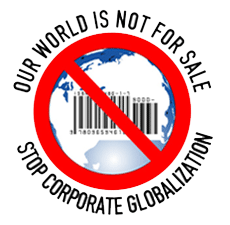| Africa Group proposes changes to NAMA Annex
TWN Report by Martin Khor, Geneva , 27 July 2004 The Africa Group has submitted proposals to amend Annex B on non agriculture market access (NAMA) in the draft “July package”. The proposal to amend the Annex is taken by observers to mean the Group has not accepted the proposal by the Chair of the NAMA negotiations, Ambassador S.H. Johannesson of Iceland, to adopt Annex B and to draft a so-called “vehicle” to explain that there are divergences of views on the Annex. It is believed that the move of the Africa Group to amend the annex enjoys the support of the ACP Group as well as several other developing countries. Among the proposed amendments are: - a mention of various proposals submitted by members and the use of these as references in further work; the deletion of the term “non-linear formula” (as the basis for further work);
- a deletion of the text that unbound tariffs should be bound at twice the applied rate, and alternative language to replace this;
- an addition that participation in the sectoral tariff component shall be voluntary; and
- an increase in flexibility, that developing countries can apply less than formula cuts to up to 15 percent of tariffs (instead of 10% in the present text) and keeping tariff lines unbound, or not applying formula cuts for up to 10% percent of tariff lines (instead of 5% in the current text).
Even before the July package had been issued, the Africa Group had registered their unhappiness with the announcement by the NAMA chairman that he had decided to reproduce the Derbez text on NAMA as an annex in the draft July package, although the Group and several other developing countries had repeatedly criticised many crucial elements of the same text at Cancun and in the post-Cancun period. Then, on 12 July, the Ministerial meeting of the Group of 90 countries in Mauritius issued a declaration on the Doha Work Programme which specifically criticised the transfer of the Derbez text to the July package. “The G90 is disappointed by the decision of the Chairman of NAMA to transmit Annex B of the Derbez Text to the chairman of the General Council as a basis for the preparation of the Framework without incorporating the concerns expressed through our various submissions during the process of negotiations. The Alliance reiterates that it is prepared to consider the framework positively only if it includes the elements we have raised in the process of the negotiations.” The G90 Ministers also criticised the Derbez text and its annex on NAMA as being “in contradiction with the principle of less than full reciprocity enshrined in the Doha Ministerial Declaration and as such would further deepen the crisis of deindustrialisation and accentuate the unemployment and poverty crisis in our countries.” The Ministerial declaration had also suggested several principles and measures for the NAMA text to incorporate. However, despite these well-known views of such a large membership of the WTO, the WTO director general Supachai Panitchpakdi and General Council chairman Shotaro Oshima still decided to accept the NAMA chairman’s proposal to incorporate the Derbez text as Annex B of the draft July package. The July draft came with a Supachai-Oshima cover note that the NAMA chair had submitted a letter of 9 July explaining “the serious divergences in positions which led him top conclude that the only practicable option was to forward the so-called Derbez Annex B to us, not as an agreed text but as a platform for the further negotiation...” When delegations reaffirmed their rejection of Annex B, the NAMA chair held Green Room consultations proposing to introduce a “vehicle” to accompany the Annex, presumably to explain the divergences of views, as his 9 July letter did. However, developing country delegations have generally been unhappy with the “vehicle” concept and process. Firstly, the drafts of the “vehicle” that they have been shown (in one instance, only to be read in the room and not for taking away!) have not properly conveyed that there are divergences of views nor what the divergences are. Secondly, where the “vehicle” is to be located has not been clarified, whether it is to be in the main text, or a prelude to the Annex, or merely a “chairman’s statement of understanding” to be read when the July package is adopted. Thirdly, the extent the to which “vehicle” will have legal force is also in doubt. The delegates point to how the “Chairman’s understanding” on Singapore issues at the closing plenary of the Doha Ministerial meeting was not even published in the Secretariat texts of (or accompanying) the Doha Declaration. Such a “chairman’s statement” may thus end up with having very little value for those delegations that do not agree with the Derbez text. According to diplomats, the latest version of the proposed “vehicle” was very disappointing in that it did not make clear that there was no agreement on Annex B, and that it did not spell out the divergence in members’ positions. The “vehicle” reportedly states that the framework in Annex B contains the necessary elements for the negotiating group’s future work in developing modalities. In adopting the Annex, the General Council recognizes that additional discussions are required on the specifics of some of the elements with a view to reaching common understanding on them and to finalizing the modalities. The “vehicle” also mentions that these elements relate to the formula, issues concerning the second indent of paragraph 4, the flexibility of developing participants, the sectoral tariff component and the non reciprocal preferences. The negotiating group is instructed to address these issues, keeping in mind the overall balance to be struck between the level of ambition and flexibility as envisioned in the Doha mandate. At a recent “Green Room” meeting, some developing country delegations reportedly raised fundamental issues regarding the wording of the “vehicle”, such as what was the meaning of “the necessary elements”, and how could “common understanding” be reached on the elements when there was none at the moment and yet these elements would be placed in the Annex.. The Africa Group reportedly told the meeting it could not accept the vehicle but wanted instead to amend the text of Annex B. The Group has submitted its amendments to Annex B . Among the proposed amendments are the following: * In para 2, “We take note of the constructive dialogue on the various proposals submitted by members and on the Chair's Draft Elements of Modalities (TN/MA/W/35/Rev.1) and confirm our intention to use these documents as references for the future work of the Negotiating Group. (Amended text is in italics). * In para 3, “We recognize that a formula approach may be key to reducing tariffs, and reducing or eliminating tariff peaks, high tariffs, and tariff escalation. The Negotiating Group should continue its work on a [to delete: non-linear ] formula applied on a line-by-line basis…… “ * In para 4, the text in the chapeau is changed from “We further agree on…” to “Consideration should be given to” the following elements regarding the formula: * The second indent of para 4 is changed to: “Tariff reductions or elimination shall commence from the bound rates after full implementation of current concessions; however, for unbound tariff lines, the basis for commencing the tariff reductions shall be determined on the basis of a methodology to be agreed.” (The previous text calls for unbound tariffs to be bound at twice the applied rate). * The amended para 5 reads: “Participants with a binding coverage of non-agricultural tariff lines of less than [35] percent would be exempt from making tariff reductions.. Instead, they shall increase the binding of non-agricultural tariff lines substantially and in accordance with their individual levels of development..” * The amended para 6 reads: “A sectorial tariff component, aiming at elimination or harmonization could be another element to achieving the objectives of paragraph 16 of the Doha Ministerial Declaration with regard to the reduction or elimination of tariffs, in particular on products of export interest to developing countries. However, participation in such arrangements shall be voluntary. The Negotiating Group is instructed to pursue its discussions on such a component, with a view to defining product coverage, and adequate provisions of flexibility for developing-country participants. * The amended para 7 reads: “ Developing-country participants shall have longer implementation periods for tariff reductions. In addition, they shall be given the following flexibility: - applying less than formula cuts to up to [15] percent of the tariff lines provided that the cuts are no less than half the formula cuts and that these tariff lines do not exceed [15] percent of the total value of a Member's imports; and/or
- keeping, as an exception, tariff lines unbound, or not applying formula cuts for up to [10] percent of tariff lines provided they do not exceed 10] percent of the total value of a Member's imports.
This flexibility could not be used to exclude entire HS Chapters. * The amended para 15 reads: “We recognize the challenges that may be faced by non-reciprocal preference beneficiary Members and those Members that are at present highly dependent on tariff revenue as a result of these negotiations on non-agricultural products. We instruct the Negotiating Group, in the course of its work, to develop appropriate mechanisms to address the needs of the Members concerned.” | 


